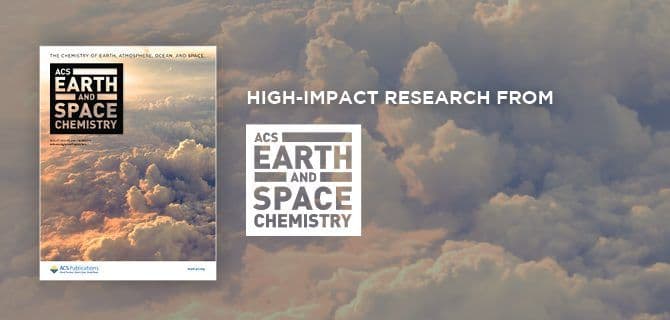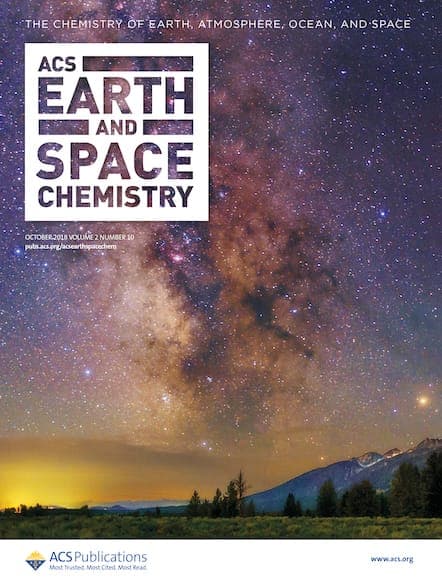In March of 2018, ACS Earth and Space Chemistry celebrated one year since its launch. From its inception, the journal has been home to the latest innovative developments in research relevant to the Earth and space, with a focus on the application of analytical, experimental and theoretical chemistry to investigate areas such as high- and low-temperature […]

In March of 2018, ACS Earth and Space Chemistry celebrated one year since its launch. From its inception, the journal has been home to the latest innovative developments in research relevant to the Earth and space, with a focus on the application of analytical, experimental and theoretical chemistry to investigate areas such as high- and low-temperature geochemistry, atmospheric chemistry, marine chemistry, planetary chemistry, astrochemistry and analytical geochemistry. The journal encompasses a highly interdisciplinary scope, while emphasizing chemistry and chemical research tools as the unifying theme.
Explore a selection of impactful research published in ACS Earth and Space Chemistry within some of the broad areas it covers:
Astrochemistry
Pathways to Meteoritic Glycine and Methylamine
ACS Earth Space Chem., 2017, 1 (1), pp 3–13
DOI: 10.1021/acsearthspacechem.6b00014
Electron-Promoted Desorption from Water Ice Surfaces: Neutral Gas-Phase Products
ACS Earth Space Chem., 2017, 1 (4), pp 209–215
DOI: 10.1021/acsearthspacechem.7b00028
Rovibrational Characterization and Interstellar Implications of the Proton-Bound, Noble Gas Complexes: ArHAr+, NeHNe+, and ArHNe+
ACS Earth Space Chem., 2017, 1 (1), pp 60–69
DOI: 10.1021/acsearthspacechem.7b000033
Atmospheric Chemistry
Criegee Intermediate–Alcohol Reactions, A Potential Source of Functionalized Hydroperoxides in the Atmosphere
ACS Earth Space Chem., 2017, 1 (10), pp 664–672
DOI: 10.1021/acsearthspacechem.7b00108
Impact of Secondary Organic Aerosol Tracers on Tracer-Based Source Apportionment of Organic Carbon and PM2.5: A Case Study in the Pearl River Delta, China
ACS Earth Space Chem., 2017, 1 (9), pp 562–571
DOI: 10.1021/acsearthspacechem.7b00088
Production and Release of Molecular Bromine and Chlorine from the Arctic Coastal Snowpack
ACS Earth Space Chem., 2017, 1 (3), pp 142–151
DOI: 10.1021/acsearthspacechem.7b00014
Earth Interior
Hydration Is the Key for Gold Transport in CO2–HCl–H2O Vapor
ACS Earth Space Chem., 2017, 1 (7), pp 368–375
DOI: 10.1021/acsearthspacechem.7b00020
The Carbonatation of Anhydrite: Kinetics and Reaction Pathways
ACS Earth Space Chem., 2017, 1 (2), pp 89–100
DOI: 10.1021/acsearthspacechem.6b00012
Earth Surface
Characterizing the Mechanisms of Lead Immobilization via Bioapatite and Various Clay Minerals
ACS Earth Space Chem., 2017, 1 (3), pp 152–157
DOI: 10.1021/acsearthspacechem.7b00016
Microscopic and Spectroscopic Insights into Uranium Phosphate Mineral Precipitated by Bacillus Mucilaginosus
ACS Earth Space Chem., 2017, 1 (8), pp 483–492
DOI: 10.1021/acsearthspacechem.7b00060
Fe(II)–Fe(III) Electron Transfer in a Clay Mineral with Low Fe Content
ACS Earth Space Chem., 2017, 1 (4), pp 197–208
DOI: 10.1021/acsearthspacechem.7b00013
